TOM FRANCIS
REGRETS THIS ALREADY
Hello! I'm Tom. I'm a game designer, writer, and programmer on Gunpoint, Heat Signature, and Tactical Breach Wizards. Here's some more info on all the games I've worked on, here are the videos I make on YouTube, and here are two short stories I wrote for the Machine of Death collections.
Theme
By me. Uses Adaptive Images by Matt Wilcox.
Search
Team Fortress 2, Episode Two And Portal
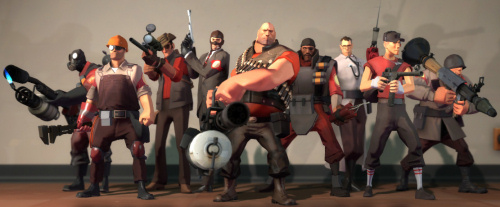
The team must have been working on this for a long time, they’ve kept it very secret, and they must have been nervous as hell about whether people would go for a cartoon look to a class-based tactical shooter. They must now be beaming, because virtually everyone seems to love it. The only whispers of dissent I’ve heard are people who love it saying “I don’t know why anyone has a problem with it, TF1 was never realistic.” I was a sceptic before they released this shot, but I see now that it is wonderful. I love their slim chunkiness, their sharp curves, even shading, their characterful but not charicatured expressions. And how cool the Spy:
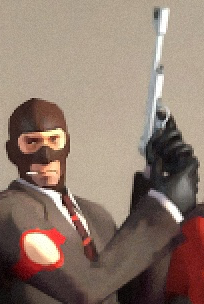
I still don’t quite understand why they’re giving it to us free with Episode Two, along with Portal – a fantastic-sounding Source-engine successor to indie gem Narbacular Drop (the best game name since Grim Fandango). My best theory so far is that it’s just to generate good will toward episodic gaming and Steam, and partially to ensure a large user-base for TF2. Maybe they were hedging their bets against the cartoon look putting people off, and ensuring that people would end up owning it whether they liked it or not. Of course, they did a similar thing with Half-Life 2 and Counter-Strike Source. We’ll never know exactly how well that did, because they won’t release Steam sales figures, but I have to assume it exceeded what they would have expected for Half-Life 2 alone. Otherwise they wouldn’t be repeating the formula with TF2 and Episode 2.
Forgetting analysis, the ripe bunch of gaming fruit that your slim twenty-dollar bill is going to bag you now looks utterly irresistable. A hefty and exotic chunk of the most finely crafted single-player game ever created; a bold reimagining of one of the all-time greatest multiplayer games using a graphical style never seen in a game before; and a completely fresh and mind-fryingly inventive experimental game, put through the mighty Valve polishing machine. Maybe that’s the point – just to put together something wonderful and profoundly worth the money to everyone. Sometimes if I feel I’ve done something well, I spend an extra half an hour to make it extraordinary, just to see how someone reacts. To hear CEO Gabe Newell talk, the faceless collective grin of an impressed gaming public – expressed through poorly spelt forum posts – is what he lives and breathes for.
Episode Three Conjecture
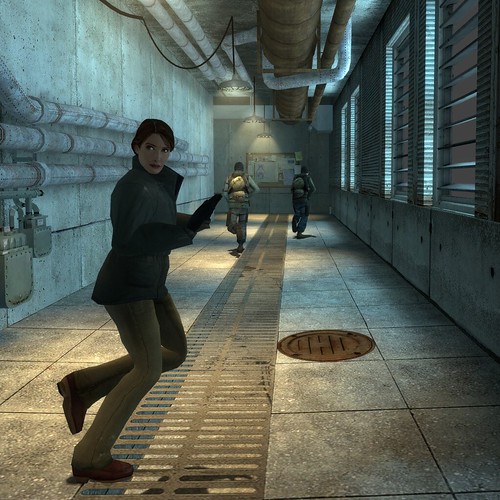
Suffering from blogger’s paralysis, wanting to talk about five different things but having no preference as to which, I’ll just stick with the theme. This is a bit silly, of course, Episode Two being six months off, but Dabs mentioned something I’d forgotten, and I looked it up, and he’s right. Raising The Bar, the superb coffee-table book about Half-Life 2’s development, mentions that at one point a large section of the game was set in an arctic base, called Weather Control. Examining a scan of a map sketch, it even mentions a ‘Judith at Weather Control’ scene.
I don’t think we’re going there in Episode Two – it’s a whole new country and Episode Two is already introducing a very large and very different environment, but we’ve been shown it now, and I really buy the idea that they’d finish the trilogy in a very different kind of place. Also of note are two aspects of Valve’s design philosophy: a) that the player should see where he’s going to end up long before he gets there (mentioned in Raising The Bar), and b) that you don’t show the player something cool then deny him it (mentioned in Gamespot’s The Final Hours Of Half-Life 2, I think). Wherever the climax of Half-Life 2: Episodes, we’ll glimpse it well in advance, and whenever it happens, we will go to Weather Control.
My final, third piece of evidence is one of the most universal tenets of videogame cliché: all expansion packs, however they’re delivered, must take you to a snowy environment.
I’m not sure how far they got with the section when it was going to be a part of Half-Life 2 – the name makes it sound like it served a Combine function like the Air Exchange, which had a lot built around it before it was cut – but there’s a short story by Marc Laidlaw in there written as inspirational material for the section. Sort of like textual concept art. It describes an intense climactic battle between Combine reinforcements who’ve tracked down the main rebel force, a last stand by the latter. Snowstorms and ice explosions. Enticing.
Episode Two Conjecture
So. This is kind of exciting. We don’t get cliffhangers in games usually, certainly not the kind the world can discuss the way we do Lost. I have some theories:
Alyx isn’t dead, obviously – Confirmed!
It’s not that I don’t believe Valve would kill her – I think they will – but they wouldn’t give it away in a trailer. She’s hurt, and I’d guess out of action for pretty much the duration, so no more faux-co-op for a while.
There will be pheropods
I think you’ll have to go into the antlion tunnels seen in the trailer (there are grubs on the walls and ground) in order to defeat a queen antlion, and take her pheropod in order to send all antlions against the Combine, including Guards. So many people loved commanding antlions in Nova Prospekt, and the pheropod’s the only weapon that doesn’t feature in Episode One. Alyx’s presence throughout E1 was a response to the positive feedback about her, and I think they’ll use each episode to go to town on something people loved about Half-Life 2.
There’ll be a vehicle, probably a new one – Confirmed!
Your train is clearly crashing only a short way out of City 17, and the place is blowing up. You’ve got to get out of there fast, and we know from the trailer that you reach Eli and the others at their hideout, well out of the blast radius. No way are you walking. The obvious choice would be the jeep again, but it was a customised one-off vehicle, and there’s no reason it would be around (no-one knew you’d crash there). I’d love to think air, since they’ve done land and sea, but it’s more likely going to be a different wheeled vehicle. My gut says no to the Combine APC – too clunky and too familiar. I also can’t imagine it’ll be a civvie car – not interesting enough. But something…
Odessa Cubbage will return, and betray the rebellion – New entry!
Raising The Bar mentions that Cubbage originally played a bigger role in Half-Life 2, and turned out to be a nasty piece of work. He was also Alyx’s father, which is referenced in a little joke Alyx makes in Episode One. That’s one of three times Cubbage is mentioned in Episode One, which I think is to refresh our memories of that character’s existence in preparation for a reappearence. He’s also an outdoorsy type, and Episode Two is going to be mostly outdoors. That’s science.
And some questions:
Where are the Advisor Pods going?
Not up, seemingly.
What information did the Combine send back to their home world?
We get no clues that I can see as to what that data packet contains, but I would guess it’s something Alyx and co don’t already know – i.e. more than just info on what the rebels are up to.
Where is Judith and what’s she doing there?
She mentions ‘what’s left of the project’ and something about information the Combine might have gathered about it. The fact that she’s in what looks to be a snowy climate implies, to me, that the Vortigaunt’s teleportation is the slow kind, like the one that skipped a week during HL2. This time you were ported a shorter distance and the time skipped was probably only six hours or so.
Will we ever meet the Hydra?
It was a City 17 thing, the only time we glimpsed it, and now City 17’s gawn.
Who’s in charge here?
Half-Life 2 made it look like a Combine Advisor was the big boss of the Combine, somewhere far off on an alien world. Episode One makes it look like there are dozens of them, all in the Citadel. It also shows us they have a weird psionic attack – it didn’t do any damage in the Citadel, but perhaps it has another effect. The Advisor pods don’t fly up to space when they eject from the Citadel at the end, they snake off above the ground. The commentary suggests that we’ll be fighting them.
Half-Life 3: Episode 1
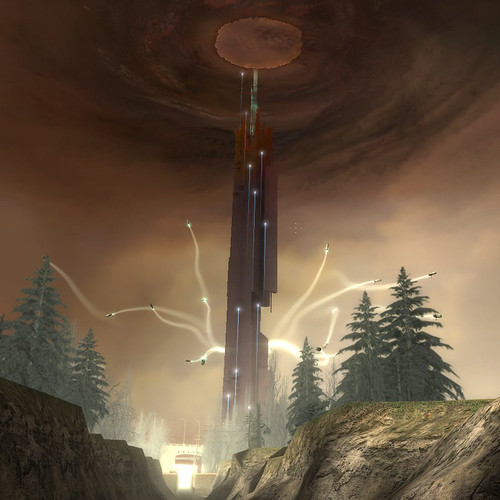
We didn’t make hats this time, but I booked the office as late as it goes (22.00), we got some Chinese food in and hung around for the release time, Craig, Graham and I. The worldwide simultaneous online launch is one of my favourite things about the Half-Life experience now, I absolutely love the feeling of a global unwrapping of this insanely exciting present. My office PC hadn’t preloaded it, absurdly, impossibly, maddeningly, so I had to scramble round to Tim’s and try not to look at Craig’s screen as he was first in. I repeatedly shouted “Shut up!” at every gasp and expletive it inspired, and tried to ignore Graham’s reaction as he got to the same bits. After scrambling wildly to install my mouse on Tim’s machine (I wasn’t about to settle for a freaking Microsoft one for something as important as this), I finally got in about fifteen minutes late, and played until Security kicked us out, which was oh-so-perfectly just as I reached the end.
Oh yes, the title – it does say Half-Life 2: Episode One on the title screen, but Gabe Newell consistently refers to this as Half-Life 3: Episode One, and indeed this episodic trilogy as the entirety of Half-Life 3. And I think its important to acknowledge the momentousness of the event – this isn’t a stopgap, this is it.
That beginning: holy shit. I don’t understand the technical bits of how the Source engine has changed, but that sequence so massively exceeds your expectations of how good Half-Life 2 can look that it suddenly feels like something properly new, not just Half-Life 2 deleted scenes. Valve have always been the only people who can make game characters touch each other properly, and the interaction between the Vortigaunts and Alyx at the start is one of the most extraordinary bits of animation I’ve ever seen in a game. All the other most extraordinary bits of animation I’ve ever seen in a game happen in the next five minutes, and most of them are on Dog.
One, of course, is being hugged. I am being hugged, by a game character. This is… nice. Perhaps slightly nicer than it has any right to be, given what it actually is. It’s not the last time the force of Alyx’s emotion surprises you – she is utterly flabergasted by your performance at one point, and is genuinely traumatised at another. All three times it jars you out of the mindset in which she is a friendly combatant, rather than a character. The rest of the advances in AI companionship are fixes rather than features – it took Herculean effort to prevent her from being annoying or a liability, but the result is by definition something you don’t notice.
Episode One’s two potential shortcomings cancel each other out: one, it’s short. Two, it’s still in City 17. Three and a half hours every six months works out to a little over one minute of game per day. I actually found its length satisfying – I did masses in that time, so it felt substantial. But it was helped a lot by the fact that I have spent a lot of freaking time in City 17. It’s the defining feature of the Half-Life games that every section is just slightly longer than the human mind can comfortably endure – you’re always a little exhausted after any given section, and it’s designed that way because that’s the threshold past which your brain registers an experience as signifcant. So every Half-Life player remembers Surface Tension intimately, whereas I couldn’t name you or describe a single level of Quake. As ever, it’s just right because it’s just wrong – it’s slightly longer than it was possible for me to enjoy a single setting, so exhaustion set in shortly before it ended, leaving me relieved to be leaving without having suffered for more than a minute or two. More than any other Half-Life location, leaving City 17 is profoundly cathartic. We’ve done, seen and felt so much there that – however wonderful it was – we never want to go back.
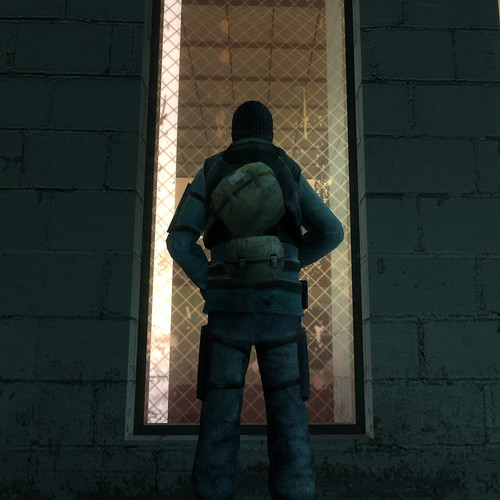
Can I Just Say
Before we go any further, that there is not a first time for everything. Some things never happen. That is kind of the point. There is a first time for everything that happens, but the irritating and sophistic catchphrase is generally used to argue against the notion that a given thing may never happen. Some things don’t. There is not a first time for these. They don’t happen. Just to be clear.
Maths Cop 2: The Revengening
I don’t usually do the link-someone-else’s-entry thing, but this is from a blog you probably don’t read, relates to a previous James post, and is easily geeky enough to inspire a response post from me. Venusberg, amused by Grey’s Anatomy’s contrast with its namesake, suggests other possible science-themed series with a keen commercial instinct:
Hooke’s Law: John Hooke is a tough New York detective. To keep the peace, he’s not afraid to stretch the law. Sometimes the strain gets to him… but it’s always proportional to the stress of the job.
I suggest:
Turing’s Test: Alan ‘Jack Johnson’ Turing is a grizzled alcoholic PI in a near-future dystopia. Earth is being taken over by android replicants, but only Alan can tell them from humans. Now he must take his test straight to the top: the President of the United States. Of Robots.
Socrates’ Method: John ‘Jack’ Plato narrates the story of the greatest negotiator who ever lived: Jack ‘John’ Socrates. By a interminable series of increasingly irritating questions, John could talk any hostage-taker, roof-jumper or bomb-wearer out of their intended course of action, and into kicking him in the neck.
Heisenberg’s Principles: Werner ‘Ice’ Heisenberg is a master car thief specialising in locating and obtaining landspeed-record-breaking vehicles for eccentric millionaires. On his last job before retirement to the Bahamas, his best friend (Niels ‘Interesting’ Bohr) turns him in. The arresting officer (Detective ‘Determinist’ Einstein) is derisive of Werner’s maverick methods, but has no choice but to offer him a deal: a dangerous street gang have stolen the five fastest cars in the world, and only Werner can work out where they are. To within (Planck’s constant / 4À) of the standard deviation.
I found Venusberg’s blog when one of my screenshots on Flickr suddenly started getting a lot of hits. I traced them back like some kind of cyber detective, to a Venusberg post questioning the virtue of ragdoll physics when it allows for travesties against man and god such as the one I had created. It was the start of a beautiful friendship.
Waa?

I don’t recall where I was when the first plane crashed into the World Trade Center, but I think I’ll always remember that I was sitting right here in the office when Nintendo renamed the Revolution.
Out Of Office Auto-Blog
I’m in America for a few more days, the end of a week-long press trip with three different companies, to see around fifteen games. Anyway, here are some photos.

Dan above the firey water feature in the LA hotel’s bar.

The X ride at Magic Mountain – the only thing in the world more extreme than a guy jumping out of a helicopter on a skateboard and the skateboard is on fire and the helicopter is exploding maybe.

I spilt my drink, and this guy pulled out that card. It was pretty surreal, but he gave us our own cards to use in the event of further accidents.

Dan and I had been to Santa Monica beach last year too, so we decided to tour it on reclining trikes this year.

A busker – or maybe just a girl playing guitar for fun – being appreciated. Drive-by photography; you don’t get the whole story.

Rollerblades are faster, but I am faster than some regular bikes on one of these. There are no gears, so you have to pedal pretty stupidly.
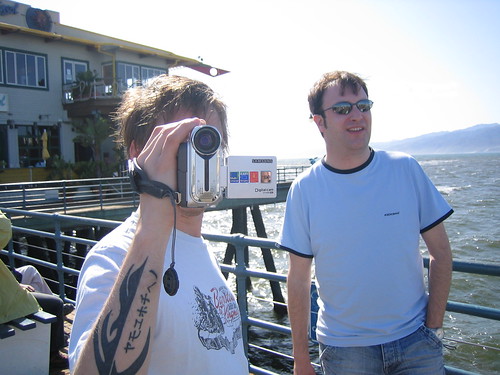
Mike makes movies of his trips for X-Box World’s coverdisc, but probably doesn’t use much of this footage.
Oblivion Review
The issue of PC Gamer that’s just gone on-sale in the UK is the one with my eight-page review of Oblivion in it, so I’d like to a) encourage you to look at it and go ‘woo!’, and b) explain why it’s structured the way it is, and how it came about. It was a huge honour to be the one to review it, and I’d actually been looking forward to writing it almost as much as getting to play the game itself. But it turned out to be one of the hardest things I’ve ever written, up there with an eight-thousand word philosophy thesis on the morality of killing replicants.
I spent a week in Eton playing the game all day every day, with one other journalist (Ryan from X360 magazine) in the demo room with me. I wrote scraps of the review on a laptop in my hotel room each night, but generally fell asleep before I got much done, or changed my mind about what I’d said within the first five minutes of playing the next day. By the end of the week, I’d written around half the review’s length, none of which made it into the final piece. Cumulative wordcount: 2,500.
Back at the PC Gamer office, I wrote the whole review quickly, but wasn’t sure if I’d talked about all the important things. Graham read it, and suggested that I may have become hung up on the details a little. I re-read it, and I appeared to have written a manual. A step-by-step guide to what Oblivion is and what happens in it is all info I’d find fascinating if I hadn’t played the game, but as a review it was fussy, dry and missed the point. Cumulative wordcount: 6,000.
I’d been wrestling with the decision of which aspects to talk about, resigned to the fact that you couldn’t cover all the important ones in a small book, let alone a magazine article. I’d also been writing up some of the best bits of my adventures as little stories, to go in separate boxes throughout, but it became clear that these were actually making the one essential point. Oblivion is hugely complex and entirely free-form, so you can’t give an impression of what it’s like to play by attempting to describe it. The only way to give a real feel for how rich with possibilities it is, and why that makes it great, is with examples. So they’ve become a chunk of the main text, punctuated by the normal business of reviewing. Cumulative wordcount: 10,500. Final article: 3,943.
Feedback so far has been really good, and much more importantly I’m now officially mentioned on Wikipedia. What I’m really looking forward to is the game finally coming out. Apart from wanting to get back to it, I want to hear what everyone else gets up to when they play.
I Took A Photograph Of You In The Herbacious Border
I have moved house and am now offline until Friday the 10th, except here at work. The new house is great – it’s solid and thickly carpeted, making it very quiet, and it’s on a street where everyone’s retired, which makes it quieter still. We had a fairly spectacular house-warming with nineteen people on Friday, the exact details of which are a little sketchy to me but I do remember enjoying it enormously. There are photos, but they’re even more blurry than my recollection – a rare triumph for organic data storage methods. We overstocked a little, or perhaps just under-served through drunken negligence, so now we have a stockpile of alcohol and snacks. Oh no!
It’s not until you’re offline that you suddenly realise how much you love Half-Life 2: Deathmatch, Guild Wars, Eve Online, Battlefield 2, and Counter-Strike: Source. It’s also made me realise that I’m never going to go back and complete Dawn Of War: Winter Assault, Brothers In Arms, Fahrenheit or The Movies – if I’m not playing them when starved of most of my entertainment forms, they can be safely uninstalled. All were fun at first, but eventually became too much of a chore. (Mass-reviewing: efficient!) Instead, I’ve been playing Deus Ex. Critical acclaim might not guarantee enjoyment, but you really get your money’s worth with the ones you like.

Unattractive* film critic Roger Ebert got a bit of attention on the gaming news sites a while back for declaring games “inherently inferior” to art because interactivity is mutually exclusive with storytelling. I’d been thinking about a post here along the lines of “I’m sorry to say it, but I just don’t believe art can ever be games. It can try to be open to interpretation all it likes, but storytelling is mutually exclusive with interactivity. It’s inherently inferior.” But the director of the Silent Hill movie raised another point I hadn’t previously considered: “Fuck him.”
* Pop culture has taught me that it’s okay to mock someone’s physical traits if they’re bad people, up to but excluding calling black villains niggers. If they’re short, blind, ugly or disabled, though: let fly.

There’s an extremely handy calendar site out there called 30 Boxes. It’s just a website laid out like a calendar, and once you’ve created an account you just click a day to add an event. The point of it is that you can obviously access this from anywhere, but more interestingly you can add friends and they can see your events (once you’ve given permission), and you theirs. It turns out there’s masses of stuff everyone’s doing that they have no particular reason to tell you about, but don’t mind you knowing. It’s not always particularly useful information to you, but like a calendar itself, it’s more about having an overview than any particular infolet (a unit of data I made up).

The issue of PC Gamer that’s now on-sale in the UK is my first cover-article – a review of the strategy game Star Wars: Empire At War. But I actually had much more fun dissecting the preview code of Rise Of Legends to find the story in The Spy (page 20), digitally enhancing a screenshot of the Far Cry guys’ next game to make out the shape of an alien in the Crysis preview (page 44), and recounting the tale of horrible cruelty that was my first few hours of playing Oblivion (page 34). Because games are impossibly rich, expansive and crazy things. It’s impossible to lose enthusiasm for them when they’re as wildly diverse and exciting as the ones I wrote about last month. It’s also impossible to predict what quirks of the worlds they create will irk any given person, making reviewing a slightly unnerving experience. And when one is not only good but perfectly suited to you, it’s impossible to tire of it. That term in literature, ‘unputdownable’ (surely ‘unputabledown’?), rarely applies beyond the last page. In games, the end is when you’re just getting started.
All of this was encapsulated in what I did this month, but I can’t talk about it for another three weeks.
World Of Lifecraft
Rich pointed me to a post putting forward the concept of Massively Multiplayer Productivity, and I haven’t been able to find anyone who’s actually come up with a formal system for how it would work. The concept is that, in order to give the menial tasks you do in real-life the same addictive quality as the menial tasks in World Of Warcraft, all you need to do is assign experience-point rewards to them. Your To-Do list becomes your Quest Log, and every few thousand points you level yourself up – you have become a superior human being by getting things done.
So all it needs is a fair system of assigning experience points to the different kinds of things life requires you to sort out, and some markers to indicate when you would level up. I suggest:
| Quest Type | XP |
| Making a phone call | 250 |
| – that involves persuasion | +250 |
| – to someone you hate | +250 |
| Filling out a form | 100 |
| – and posting it | +50 |
| – and losing it | –100 |
| Physical labour | 250 |
| – that takes more than half an hour | +250 |
| – that takes more than an hour | +250 |
| Going to an appointment | 500 |
| – and resolving a problem while there | +250 |
| – and discovering you are terminally ill | +500 |
| Cleaning a room | 500 |
| – including removal of blood stains | +500 |
| Going shopping for groceries | 250 |
| Working outside of work | 250 |
| – for more than forty-five minutes | +250 |
| – just to get ahead | +250 |
| Doing someone a favour | 250 |
| – that takes more than half an hour | +250 |
| – that involves assassination or insurance fraud | +750 |
| Blogging | 100 |
| – about World Of Lifecraft | +150 |
Level-ups are awarded for the following XP amounts:
| Progress | XP | Reward |
| Level 1 | 500 | Consumption of an unhealthy food. |
| Level 2 | 1000 | Consumption of an expensive and unhealthy food. |
| Level 3 | 2000 | A frivolous purchase =< £5/$10 |
| Level 4 | 3500 | Home delivery for your next groceries purchase |
| Level 5 | 5500 | Immediate consumption of eight units of alcohol |
| Level 6 | 8000 | A frivolous purchase =< £15/$30 |
| Level 7 | 11000 | Moral absolution for one theft – past or future |
| Level 8 | 14500 | Home delivery for your next narcotics purchase |
| Level 9 | 18500 | A frivolous purchase =< £50/$100 |
| Level 10 | 23000 | Moral absolution for the contract-killing of one unwanted person |
And so on. (If you didn’t spot the pattern, you’re probably not geeky enough to need to turn your life into a MMOG in order to get anything done). Notice that you start at level 0, just to emphasise how worthless you are until you’ve done something.
Well, I’m level one already and I haven’t had breakfast, so I think a bacon sandwich is in order. Any suggestions for more quest types or rewards?
Some News, JC
Seven hours left of the year – another good one, actually. Last year I got a job at PC Gamer, this year I got the job I’d always wanted at PC Gamer. I also got a raise and a house. Did I tell you about the house yet? I’m not allowed to move in until the 12th, but I have a key now:

So I’m counting it as this year. It looks like this:

It was an old man’s house, and he died. It looks very much like an old man’s house inside right now, but we’re going to modernise it heavily. There are dozens of picture hooks which presumably held precious memories and images of loved ones – I’m going to put up framed prints of my favourite screenshots, which is basically the same thing.
The key was a Christmas present. I thought I’d lost my camera for a while, so when I discovered I hadn’t (I refused to look for it for about a month on the grounds that, so long as I hadn’t attempted to find it, I had not in any real sense lost it) I went mad taking photos of everything. It’s hard to get far enough away from normal scenes to make them look interesting (as they are from a plane, for example), so you’ll notice most of my photos are extremely close up instead. This, for example, is a beach at sunset:
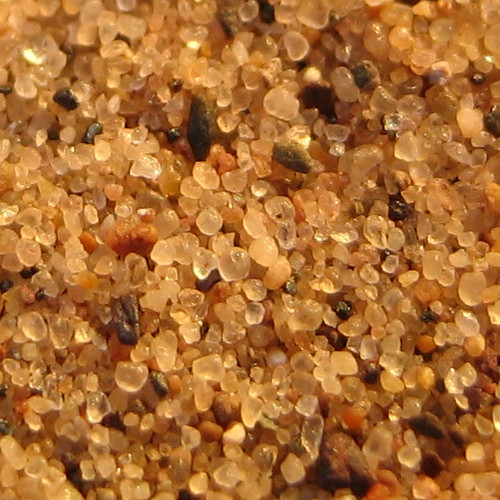
Interesting thing I learnt about macro mode over a year ago, then completely forgot until recently: it’s much better if you zoom out, then just put the lens very close. My brain is rubbish.
Recommendations are stronger when you make fewer of them, so for my Stuff Of The Year awards I’m limiting myself to two choices per medium.
Games
1. Battlefield 2. Just before I first set eyes on this, I had to sit through a series of presentations about various console-only games. It was embarassing. I was scared someone from the outside world might peer in and think this was what games were like. When we finally sat down in a lecture theatre and Battlefield 2 popped up on the projector, it was a blissful homecoming to the amazing worlds where I spend my time. Vast, crisp, luscious and magnificently complicated. The social hierarchy of the voice comms system alone is an elegant work of genius. It’s one of those sequels that goes a little too far in improving on the original, and we end up wondering how we ever could have been satisfied with the crude toy that one of the most important games ever made now looks like. Even if you ignore the brilliant, endlessly emotional, ingeniously designed game – and for a long time we did – the fidelity of the world alone makes it extraordinary to be in. The ludicrously thrilling speed and solidity of the jets, the earth-shattering apocalypse of an artillery strike, the exquisite sense of place in every forest, street, mountain and desert. Magnificent.
2. Darwinia. The second-place stigma is misleading, this is the best strategy game ever created – I just have an enormous bias toward first-person games. Ignore if you can the sumptuous style and heart-melting story, what makes my brain explode with delight every time I play Darwinia is the satisfaction of doing almost everything myself. You hold your army together with both hands, controlling your most powerful troops manually while your unpredictable horde of Darwinians flow according to the fluid channels of command you hastily set up for them. It sounds overwhelming, but every task is a game rather than a chore, so everything you’re scrambling to do is fun in itself.

Films
1. Serenity. If you liked Revenge Of The Sith, you should definitely see Serenity. It’s not similar, and I’ve never heard of anyone liking both, but you will I hope break down in tears when you realise the error of your ways. It’s sci-fi your sci-fi-hating friends, girlfriend, mother and luddite cultists will like, because it takes an innovative extra step of actually being good, so it works whether space excites you or not. It excites me a lot. Apart from being witty, emotional, character-driven fiction, Serenity is wonderful epic sci-fi; full of horror, assassins and bureaucracy.
2. Kiss Kiss Bang Bang. I so nearly didn’t go and see this, but quickly checked the Onion AV Club’s review, discovered it was a “a noir-inspired L.A. mystery that isn’t afraid to show some satirical teeth” and bolted for the door. It is exactly my kind of thing. It’s endlessly cool, incredibly funny, frequently dark, and genuinely thrilling.

Music
1. In Case We Die (Architecture In Helsinki). The most fun you can have with your ears.
2. Twin Cinema (The New Pornographers). Spoiled slightly for me by having the best tracks – Bleeding Heart Show, Sing Me Spanish Techno and Twin Cinema – released on various MP3 blogs before the album proper was available. Spoil it for yourself too and listen to those.
More random images of Christmas follow. Have fun tonight/last night.



Villainy Like It Oughta Be
That is a Ben And Jerry’s joke.
I’m playing City Of Villains more than anything else lately, and I hate it. Well, no, I just resent it a lot. I don’t know why my fellow Heroes-lovers rate it so highly. After Heroes, I thought Cryptic were prepared to do brave, liberal things to make sure their games captured their themes gloriously. Then when their next theme was, excitingly, the polar opposite of their first, they refused to change anything at all. They just did a search-and-replace operation on the word ‘hero’ for ‘villain’ and charged full-game price for it. It’s not that I didn’t love Heroes, it’s that I still love Heroes, and I can still play it, so what the hell is the point of this new thing?
I’m talking in degrees, of course – there are some small token additions in Villains, there’s one new class, one half-new class and three recycled classes. But it’s not nearly enough, and when Heroes’ instanced missions were already absurdly repetitive, to give you utterly indistinguishable ones in Villains – usually against the exact same villain groups you were fighting in CoH – is criminal. But I’m not here to bitch, I want to explain why this is so disappointing by describing what would have been great.
Classes
The new class in Villains is the Mastermind, who has minions to do his dirty work. Ace. I’m not playing as a Mastermind, though, because the power sets are absurdly limited. In their bizarre attempt to cram the whole rationale of villainy into a single class, they’ve had to make your primary weapon and your minion type part of one power set. In other words, if you want ninjas, you have to use a bow. What the hell? Couldn’t it at least be a ninja-y weapon, like throwing stars? Anyway, clearly all classes should have minions of some type, and clearly you should be able to choose your weapon separately from your minion type, and clearly you should be able to customise your minions’ appearence with the costume editor. In fact, let’s separate minions from class completely – you choose a primary power set similar to the existing ones, then your next choice is what type of minions to have, and all classes can have any type. Here’s what the options would be:
Mob: A steadily increasing gang of lackeys, dumb cannon fodder but nevertheless an intimidating presence. They don’t increase in power by as much as you per level. Each new power is a new lackey, and each lackey has somewhat different abilities, but not necessarily better ones than the last. If one dies, you can res him by activating that ‘power’, but it has a longish recharge time. By max level you could have nine of them. Each time you get one, you get to design his appearence. The default is the same as the last lackey, so you can just make few or no alterations if you like.
Posse: Right from the start, you’ve got three loyal servants. They’re weak to begin with, but every new power is an upgrade to all of them, giving them all a new ability or resistance. You never get more than three, and their abilities are always identical to one another. You design their appearence, but it’s a uniform for all three. You can res one at a time, but the power has a long recharge time.
Henchmen: You have two bodyguards, potentially with different abilities and appearence. Each new power you get is an upgrade to one or the other, alternatingly.
Lieutenant: You just have one trusted right-hand man, but he’s every bit as powerful as you. You even choose a class for him from the same options you had, so he can be designed to compliment your own abilities. Each new power is just a new power in that set.
Twin: You’re one of a pair, so your associate is identical to you in appearence and abilities. Each new power you get for yourself, he gets too. The actual ‘Twin’ powers are ways to help each other out: the ability to resurrect him, for him to resurrect you, synchronised attacks that do more damage than the sum of their parts, linked health, and eventually the ability to switch which one of the two you control. These make up for the fact that, unlike a lieutenant, your twin’s powers don’t compliment your own.
Missions
Again, they had one nice idea and didn’t use it much. Getting missions from the newspaper – carrying out personal vendettas, responding to false stories about yourself, building your rep as a bad guy – is all great. But so futile since none of these missions have any continuity, and the thing they build toward – a bank robbery – is the same each time. So you end up doing Contact missions most of the time, just like Heroes.
Paper missions should be the only ones. You’re not working for anyone, you’re a super-villain, not a grunt. The ability to rob a bank should stay, but you should – and I know this is going to sound a little extreme – get some money for it. As it is, you get a ‘clue’ saying “I scored half a million from that job – not bad for a days work!” No you didn’t. There is no money in Villains. There’s a currency called Infamy, of which you received a tiny amount, but the rest is all in your head.
You should have actual money. Infamy is an equivalent of Heroes’ Influence, which made sense because heroes don’t work for money. Villains do. I should be getting money, especially if I steal a load from a bank. I should also be able to mug innocents by hitting them a few times (I understand if I’m not allowed to properly kill them – it’s a kid-friendly game). Beating up heroes too low level to give me XP should get me money, too. I should want to beat the hell out of more or less everyone I see.
The instances themselves only really need two improvements: a logical random level generator and no missions against villains. At all. Currently ninety percent of all the missions I’ve done have been against villains – many of them against the very villain faction I work for. Which doesn’t feel like betrayal, since most of them attack me on sight in the streets anyway, even on my way back to their boss to be trained to the next level. Idiotic.
Missions against heroes should be a case of beating up cops to get to something to steal it, fending off small groups of powerful (NPC) heroes who enter the instance to stop you, or beating up innocent people to make a scene, baiting a specific hero to come out and be ambushed. Villainous things. Defeating the evil snakes because someone asked me to is a god damn service to society, not a nefarious caper.
That’s why it disappoints me. The reason I’m playing it anyway is that the Always Black forum has a supergroup, and I was never really in one of those for Heroes. And it’s fun, in so far as it resembles Heroes.
FEAR
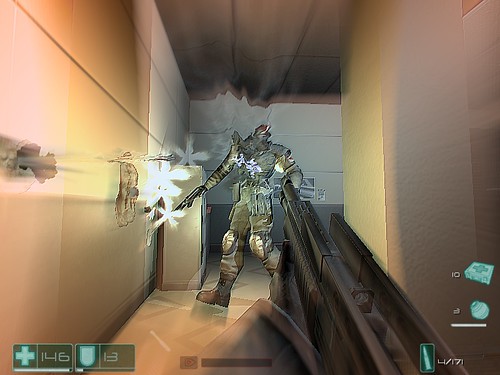
Wrote this back when it was relevant. I hope enough time has now passed that I can post it without pretensions of currency.
Central to FEAR is this idea of being surrounded by armoured grunts in a classy office, bullet trails streaking in all directions in slow motion, dust and sparks exploding all around, then blowing one of them in half with the shotgun and launching into a flying kick at another while he shouts a slow-mo deepened “Fuck!” They got that exactly right, and it’s one of the all-time top ten essential gaming experiences everyone should have before they die.
But it sometimes feels like they didn’t know what to do around that. Their attempts to deviate from that formula for variety’s sake – excluding the horror sections – are all rather awkward. The extra-tough enemies are dull, the turrets are a chore to destroy, the flying robots are desperately incongruous and almost impossible to defeat stylishly, and the psychic demons that can hurt you and be shot are a catastrophic midjudgement. Instead of being scary and fun to fight, they’re neither – that they’re vulnerable to bullets makes them mundane, and that they zoom mindlessly towards you makes them insultingly poor opponents.
The one exception is the stealth troop type – they’re both genuinely different and great fun. But even that gives rise to a further frustration – they’re horribly under-used. Especially given that they are both scary and fun to fight, and that’s clearly what they wanted from the later levels. Instead, they’re replaced by the aforementioned physical demon things in the last levels, and then and there FEAR drops from one of the best games ever made to merely something with a lot of potential. All other quibbles are barely that – quirks, more like; blemishes in a beautiful skin.
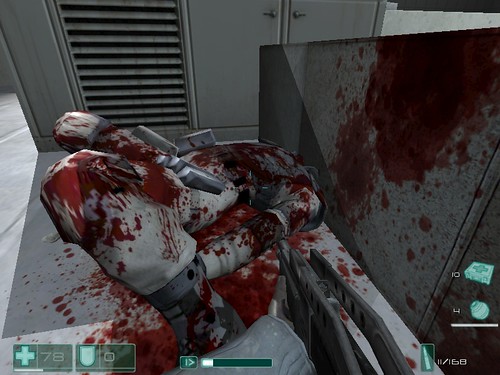
It still feels like a 90% game to me, despite everything, so I shall specify some of the things it does better than anyone else ever before. I hearby give FEAR the following awards:
- Best FPS Combat – a big one, but well-earned.
- Best Enemy ‘Barks’ – for ‘Fuck!’, “Shit!’, “Fuck, shit!”, “Shut the fuck up!” and “No fucking way!”. I honestly never thought I’d have to take this award away from Far Cry’s mercenaries with their twin classics “Yeah yeah!” and “I’m going to shoot you in the face!”
- Best Costume Design – the grunts are all functionally identical, but they sport a range of genuinely stunning uniforms. They’re sleek, they’re formal, they come in tasteful colours (particularly the crimson/white/black one later on) and yet they look like they mean business. Sadly there isn’t a specific credit for costume design in games, since technically they’re not costumes (“These clothes are my skin!” – prize for placing the (mis)quote), but I’m inclined to credit these outfits to John Turner, Senior Character and Weapon artist.
- Best Shotgun – sorry Half-Life 2, but holy shit this is a good shotgun.
- Best AI – I know it has its flaws, but the deciding factor is that these are the only enemies that continually surprise me.
- Best Explosion – and I mean ever. I’m not even restricting this to games. This beats Akira.
- Most Arbitrary Plot Twist – for the one after the credits. “Er, okay.” I’m willing to be corrected on this one – I know there’s a lot of hot competition.
- Best Enemy – for the grunts. If I have to be specific, let’s say one in a blue-grey/white uniform, using a shotgun. Cool, challenging and incredibly satisfying to beat up.
- Best Enemy In A Supporting Role – for the stealth dudes. Creepy, cunning and brilliantly acrobatic.
- The Sands Of Time Award For Worth-Copying Contribution To The Genre – for the melee combat. Take note, everyone: we need melee moves, they need to be powerful and we need to be able to do them without switching away from our regular weapon.
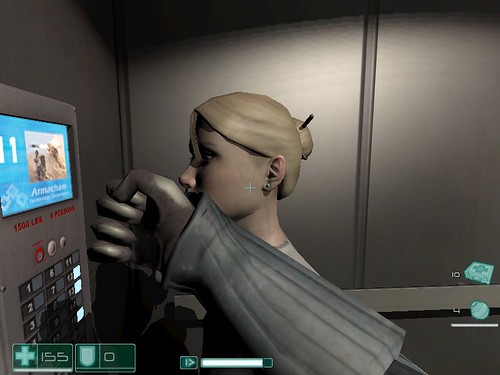
Battlefield 2 Stats
I’ve now killed a thousand people. I’ve died fifteen hundred times doing it, but I’ve saved three hundred and fifty lives along the way. It’s taken me forty-six hours. I’ve won a hundred and one games, and lost ninety-one. That makes me a positive influence. If you see me on the enemy team, you should think “Uh oh, they’ve got Tom. That makes them more likely to win (than they would be otherwise).” I’ve killed twenty-four people with the knife in seven minutes of using it. My single worst-performing map – the one on which my win-to-lose ratio is lowest – is the one that comes up most often in the rotations on the servers I play on. I am cursed.
Battlefield 2 stats are interesting. More interesting is the game itself, my love for which was rekindled tonight when trying out Special Forces. Virtually nothing that’s new in SF had a bearing on the match, so it was basically just a revival. I hadn’t played online for months because Craig, Steve and I had discovered how much fun it was to try aerial stunts on a private LAN server – jumping from one helicopter to another in mid-air, for example. It’s completely different to the normal game, but somehow replaced it in my affections, leading to total neglect even after we stopped really doing the stunts thing too.
Tonight I played Medic, as I always do. I’ve spent less than fifteen percent of my time as classes other than the Medic. Sorry, it’s hard to shake the stats thing. It was a spectacular, incredibly tense and fiercely competitive game tonight – me, an excellent player on my team, and the star player of the enemy team all jostling for the top spot, all pretty sure we’d get a medal (Bronze, Silver or Gold) but all extremely ‘interested’ in which one it would be. I began swearing a lot, even though I was ahead. But somehow my complete jerkishness when playing Battlefield 2 never detracts from what I’m actually doing to get this score up – killing bad guys and saving lives. That remains an utterly pure, deeply instinctive and almost medatative act. When I see a black bar – a dead ally – the defibrillators come out seemingly without me moving my fingers, and he’s resurrected and his foes killed in almost the same motion. Even as I ask the enemy if they like that, cocksuckers, ha, didn’t think so, I care profoundly about the friend I’ve just saved, drop him a medkit in case he gets hurt again, respond to his manly “Thanks man,” with a stoic “You got it.”
I am a pure force, tipping the balance in our team’s favour in both ways – giving to one, takething away from the other. And I score one and a half points per minute.
